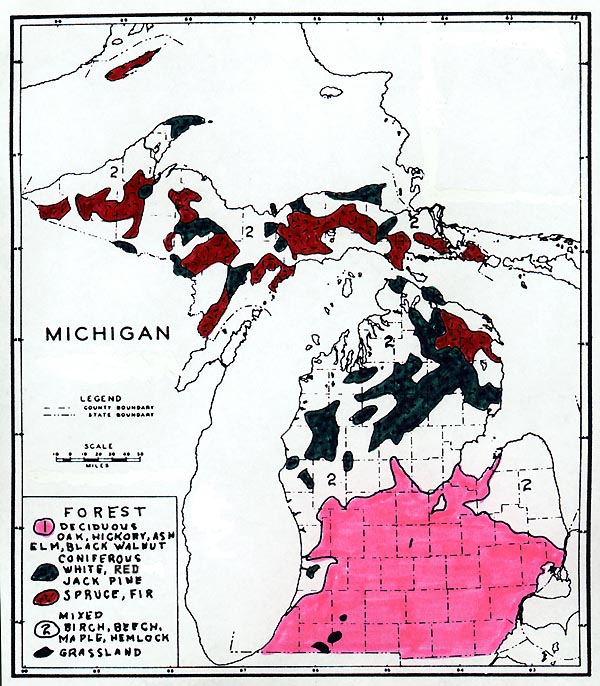OAK-HICKORY and BEECH-MAPLE FORESTS
Upland forests south of the tension zone are generally of either oak and hickory or beech
and maple composition. The drier oak-hickory forests are most commonly found on porous,
loose-textured (sandy) soils (except near Lake Michigan). The dominant species include
black, red, white, and bur oaks, shagbark and pignut hickories, black cherry, black walnut
and red maple. These forests have an open canopy that admits considerable daylight to the
forest floor, even during the summer.
Oak stands were generally open, with some sunlight reaching the forest floor.
Source: Photograph courtesy of Randy Schaetzl, Professor of Geography -
Michigan State University
The maps below show where such forests existed in presettlement times: pink areas below

Source:
Unknown
The pink areas in the map above contained not only oak-hickory forests, but other kinds as
well. Thus, the map below shows more accurately where the oak-hickory stands were,
in the gray striped areas below, in SE lower Michigan:
Source:
Unknown
Source: Photograph courtesy of Randy Schaetzl, Professor of Geography - Michigan State University
The distinctive leaves of oak trees make recognizing them very easy. Oaks, like the pin
oak shown here, are highly competitive on sandy, dry soils. Many oaks also have the
ability to resprout after fire, quickly re-establishing their dominance on sandy,
fire-susceptible landscapes.
Woodlands of southern Michigan that are dominated by beech and sugar maple contain more plant species than do their dry-site counterparts. Most common on soils of heavier texture (loams) that are not excessively drained, these species are often found with red oak, basswood, white ash, tulip tree, black cherry, black walnut, and bitternut hickory. Although beech-maple stands share some dominants (black cherry, red oak, white oak) with oak-hickory stands, they have a more luxuriant aspect during the period of summer foliage.
Parts of the text on this page have been modified from L.M. Sommers' book entitled, "Michigan: A Geography".
This material has been compiled for educational use only, and may not be reproduced without permission. One copy may be printed for personal use. Please contact Randall Schaetzl (soils@msu.edu) for more information or permissions.